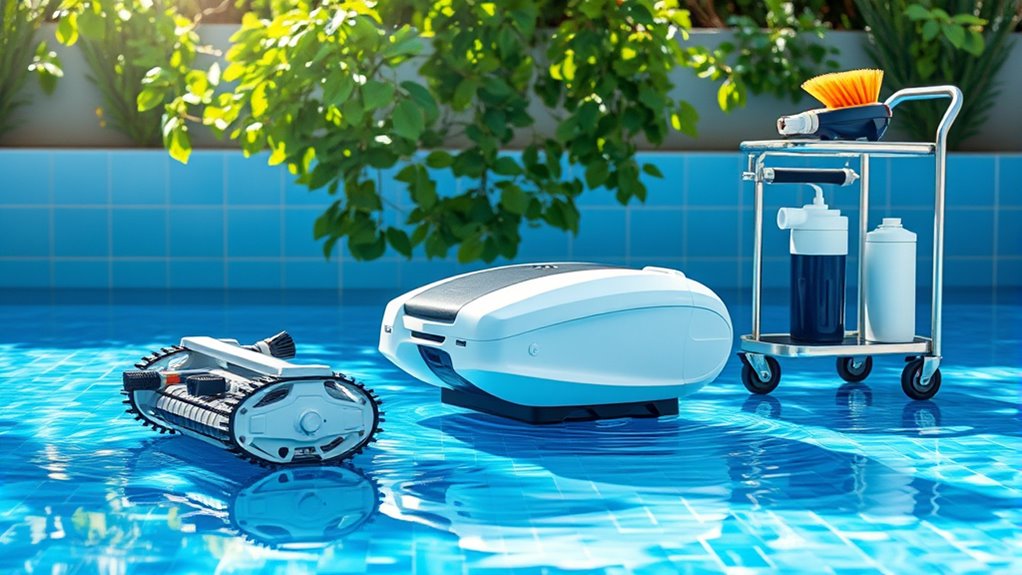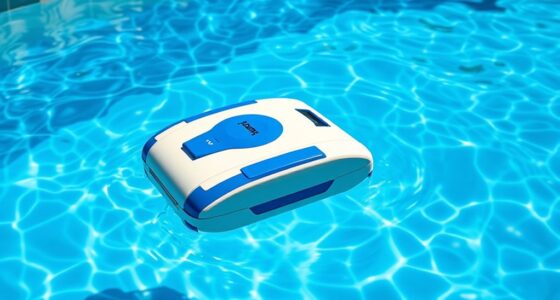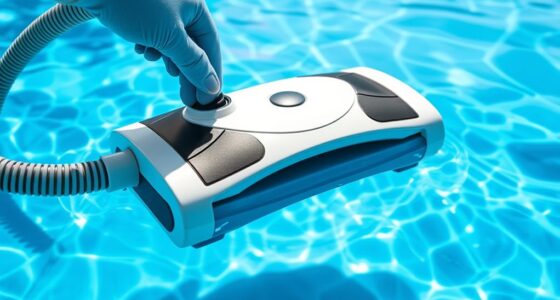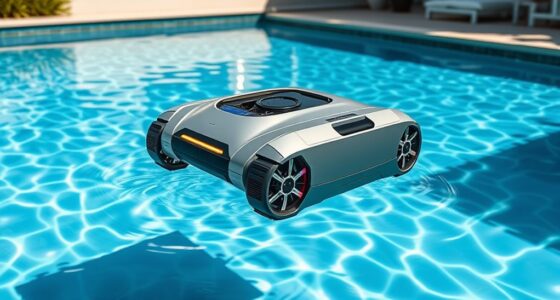To keep your automatic pool cleaner running smoothly, regularly clean and rinse the filter, inspect hoses for cracks or blockages, and keep all components like brushes and wheels free of dirt. Lubricate moving parts and replace worn items promptly. Following manufacturer guidelines and scheduling routine inspections helps prevent costly repairs. Incorporate these simple practices to extend your cleaner’s lifespan and maintain peak performance—continue with the next steps to learn even more tips for effortless pool maintenance.
Key Takeaways
- Regularly clean and rinse the filter to prevent clogging and maintain optimal water flow.
- Inspect hoses for leaks, cracks, or blockages, and replace damaged sections promptly.
- Keep brushes, wheels, and drive belts free of debris; lubricate and replace worn parts as needed.
- Follow manufacturer guidelines for scheduled maintenance and component replacements.
- Use AI insights and routine inspections to optimize maintenance and prolong cleaner lifespan.
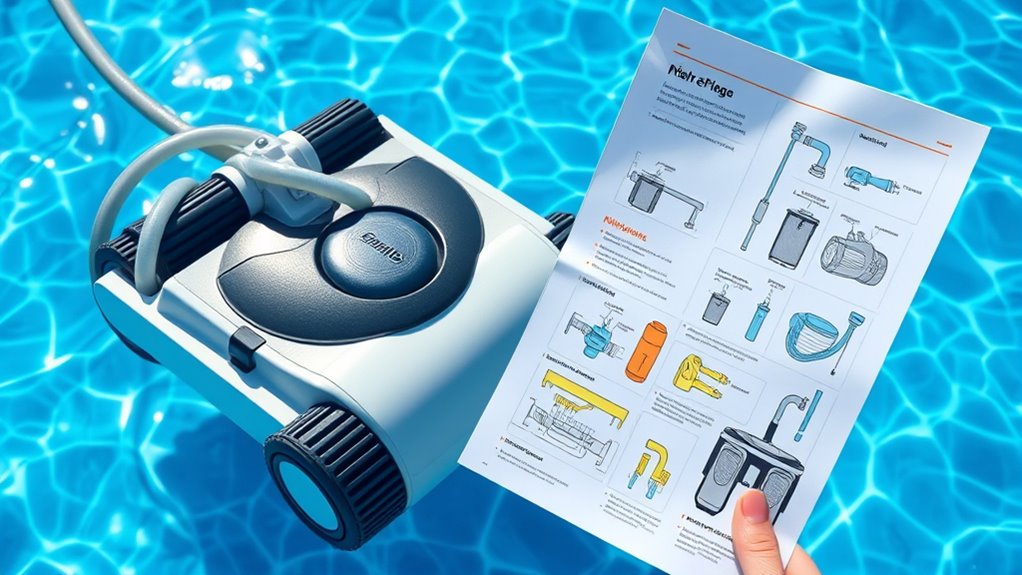
Maintaining your automatic pool cleaner is vital to keep your pool sparkling and guarantee the device works efficiently. A well-maintained cleaner not only improves cleaning performance but also extends its lifespan. The first step in maintenance is regular filter cleaning. Over time, debris, dirt, and oils clog the filter, reducing suction and cleaning effectiveness. To clean the filter, turn off the cleaner and remove the filter cartridge or bag, depending on your model. Rinse it thoroughly with a garden hose, making sure to dislodge trapped debris. For stubborn dirt, soak the filter in a mild soap solution, then rinse again until it’s spotless. This process guarantees maximum water flow and prevents strain on the cleaner’s motor, helping it operate smoothly during each cleaning cycle. Regular filter maintenance also prevents bacterial growth and odors that can develop in clogged filters, ensuring healthier pool conditions.
In addition to filter cleaning, inspecting the hose is essential. The hose carries debris from the pool to the cleaner’s internal filter, so any cracks, leaks, or blockages can impair performance. Carefully examine the entire length of the hose, checking for signs of wear or damage. Replace any cracked or leaking sections immediately, as these issues can cause loss of suction or allow debris to escape back into the pool. Also, ensure the hose connections are secure and free of obstructions. A clear hose promotes proper water flow and prevents clogs that can hinder the cleaner’s movement. Regular hose inspection is especially important after heavy storms or high usage periods, as debris can accumulate and cause blockages or damage. Properly maintaining the pool equipment helps prevent costly repairs and ensures consistent cleaning results. Additionally, understanding the technologies used in your cleaner can help troubleshoot issues more effectively and optimize performance.
Beyond filter cleaning and hose inspection, it’s wise to check other components like brushes, wheels, and the drive belt, if applicable. Keep these parts free of dirt and debris to maintain their effectiveness and prevent unnecessary strain on the motor. Lubricate moving parts if recommended by the manufacturer, and replace worn-out brushes or wheels to guarantee the cleaner navigates your pool efficiently. Additionally, after each use, rinse the entire device with fresh water to remove residual dirt and chemicals that might cause corrosion over time. Incorporating routine maintenance practices ensures your automatic pool cleaner remains in optimal condition and prolongs its operational life. Regularly reviewing the manufacturer’s guidelines can also provide specific advice tailored to your model, ensuring optimal performance and longevity. Moreover, leveraging AI and automation insights can help you schedule maintenance more effectively and prevent unexpected breakdowns.
Frequently Asked Questions
How Long Does an Automatic Pool Cleaner Typically Last?
An automatic pool cleaner usually lasts around 3 to 8 years, depending on usage and maintenance. Your cleaner’s lifetime expectancy can be prolonged with proper care, like regularly cleaning filters and checking hoses. Follow maintenance tips such as storing it in a dry place and inspecting parts often. By taking good care of your cleaner, you’ll ensure it stays efficient and lasts as long as possible, saving you money in the long run.
Can I Use Household Cleaners to Maintain the Cleaner?
You should avoid using household cleaners on your pool cleaner because of household cleaner safety and chemical compatibility concerns. Many household cleaners contain harsh chemicals that can damage the cleaner’s parts or impair its function. Instead, use manufacturer-recommended cleaning agents and follow the proper maintenance procedures. This guarantees your automatic pool cleaner stays in good condition, lasts longer, and works efficiently without risking damage from incompatible chemicals.
What Is the Best Way to Store the Cleaner During Winter?
For winter storage, you should clean your pool cleaner thoroughly, removing debris and rinsing it with fresh water. Store it in a cool, dry place away from direct sunlight to guarantee proper cleaner protection. Make sure the filter and brushes are dry before storing. This prevents damage and prolongs its lifespan. Proper winter storage keeps your cleaner ready for use when swimming season begins again.
Are There Specific Water Conditions That Can Damage the Cleaner?
You should be aware that certain water conditions can harm your cleaner. Poor water chemistry, like imbalanced pH or high chlorine levels, can corrode parts. Additionally, debris buildup can clog the brushes and filters, decreasing efficiency. To protect your cleaner, regularly test and adjust water chemistry, and remove debris promptly. Avoid using it in water with excessive dirt or algae, as these conditions can cause damage over time.
How Often Should I Replace the Cleaner’S Brushes or Parts?
Your pool cleaner’s brushes and parts are the unsung heroes of spotless swimming! Typically, you should replace the brush during regular part maintenance every 3 to 6 months, but this can vary based on usage and water conditions. Keep an eye out for signs of wear—frayed bristles or cracked parts—and replace them promptly. Regular brush replacement guarantees your cleaner works efficiently and prolongs its lifespan, making pool maintenance a breeze!
Conclusion
Maintaining your automatic pool cleaner is simple and rewarding. With consistent cleaning, careful checks, and timely troubleshooting, you’ll keep your pool pristine and perfect. Remember, regular rinsing, replacing, and reviewing prevent problems before they start. By dedicating a little time and effort, you’ll enjoy endless, effortless enjoyment in your sparkling, serene swimming space. So stay vigilant, stay vigilant, and let your diligent maintenance deliver dazzling, dirt-free dives all season long!
